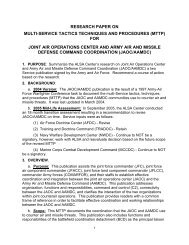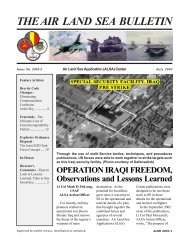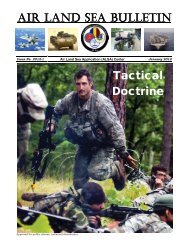AIR LAND SEA BULLETIN Attack the Network - ALSA
AIR LAND SEA BULLETIN Attack the Network - ALSA
AIR LAND SEA BULLETIN Attack the Network - ALSA
Create successful ePaper yourself
Turn your PDF publications into a flip-book with our unique Google optimized e-Paper software.
NETWORKS IN THE OPERATIONAL ENVIRONMENT …<br />
HOW CAN WE EXPLOIT THEM?<br />
Mark Covey, far right, of Systems Integration Modeling and Simulation for Joint Training Counter-Improvised Explosive Device Operations<br />
Integration Center (JTCOIC), demonstrates JTCOIC's capabilities for simulation for an unidentified colonel, left, Under Secretary of <strong>the</strong> Army<br />
Joseph W. Westphal, second from left, and LT GEN Mark P. Hertling, center, at <strong>the</strong> JTCOIC office in Newport News, Virginia, 16 July 2010.<br />
(Photo by SGT Angelica Golindano, USA)<br />
The purpose of<br />
network analysis<br />
is to support<br />
planning for<br />
network engagement.<br />
By Training Brain Operations<br />
Center (TBOC) and U.S. Army<br />
Maneuver Center of Excellence<br />
<strong>Attack</strong> <strong>the</strong> <strong>Network</strong> Teams<br />
“Context is king. Achieving an understanding<br />
of what is happening… comes from a truly<br />
integrated picture of an area, <strong>the</strong> situation,<br />
and <strong>the</strong> various personalities in it. It demands<br />
a layered approach over time that<br />
builds depth of understanding and context<br />
...” 1 LTG Michael T. Flynn and BG Charles A.<br />
Flynn, United States (US) Army<br />
Most military personnel think<br />
of ei<strong>the</strong>r computer network activities<br />
or lethal targeting operations when<br />
<strong>the</strong>y hear <strong>the</strong> term ―<strong>Attack</strong> <strong>the</strong> <strong>Network</strong><br />
(AtN)‖, but kill/capture operations<br />
are just narrow elements within<br />
<strong>the</strong> AtN lines of effort, as currently<br />
defined. Among o<strong>the</strong>r things, AtN includes<br />
conducting actions and oper-<br />
ALSB 2012-2 14<br />
ations to support friendly, neutralize<br />
threat, and influence neutral networks.<br />
Fur<strong>the</strong>rmore, nei<strong>the</strong>r kill/capture operations,<br />
nor neutralizing threat networks<br />
represent <strong>the</strong> decisive effort<br />
within AtN. The decisive line of effort<br />
is often supporting friendly networks.<br />
The purpose of network analysis<br />
is to support planning for network<br />
engagement. In this context,<br />
network engagement is comprised of<br />
five lines of effort and six pillars. 2<br />
This article focuses on developing a<br />
better understanding of three of <strong>the</strong><br />
five lines of effort and two of <strong>the</strong> six<br />
pillars. The lines of effort being considered<br />
are: support friendly networks,<br />
neutralize threat networks, and influence<br />
neutral networks. The two<br />
pillars are: understand <strong>the</strong> operational<br />
environment (OE) and understand





